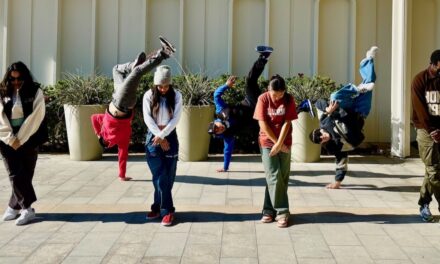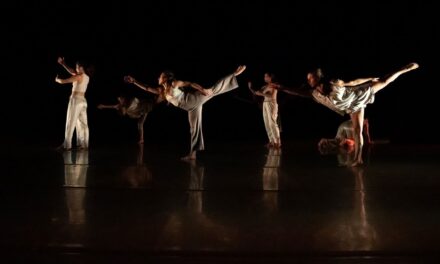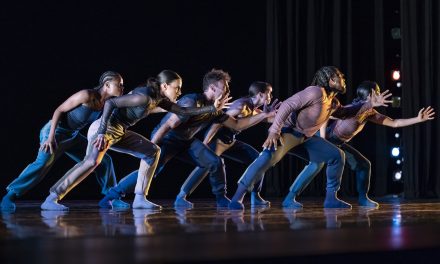When thinking of acrobatics mixed with dancing, Cirque du Soleil is usually the first company that comes to mind. Their deft defying stunts, rich costumes and incredible set design create an atmosphere unlike any other. But what happens if you tone down some of the theatrics until left with something simpler and a little more dance-based? Then you get Montreal’s Les 7 Doigts, or The 7 Fingers, as they are called in English.
Gracing The Broad Stage for the second time since their 2017 tour of Cuisine & Confessions, the troupe performed their latest show, RÉVERSIBLE, in Santa Monica between February 15 and 17 to wide success and cheering audiences. The show, which briefly explores the lives of the eight artists’ grandparents, is touching, funny and melancholic all at once. Several segments of somersaults, pole climbing, aerial silks, and trapeze artistry come together to form an explosive 90 minutes of fun. A few of the scenes seem disconnected from the storyline, but none of this takes away from the excitement.
RÉVERSIBLE opens with the entourage on stage dressed in retro street clothing (designed by Geneviève Bouchard) in front of an old-style building resembling a small village home. They take turns expressing their admiration for their grandparents in single-line descriptions spoken directly to the ancestor they admire. No names are uttered, which at first makes it seem as though they are all referring to the same person, until their words begin to reveal different histories. Stories of running away, marrying young, painting, sailing, living and dying loosely define a myriad of inspirational personalities belonging to men and women from all over the globe (emphasized by the program mentioning the performers’ countries of origin). Their lives are later honored in acts involving everything from calm, domestic scenes, to exotic shipwrecks.
As the more sentimental segment comes to a close, the group attacks the prop behind them, diving directly into and out of the doors, windows and a doggie door poised along the its façade. Locking each other out, feeling trapped within, appearing on the roof, emerging upside down, dragging, then separating one another as they transition through and beyond the walls — the artists find every possible way to enter, exit and pose upon the building, while also taking time to duet in short twisting and curving dances along its perimeter. Their “nervous”, joyful and purposely awkward expressions are reminiscent of clowns, but with a more modern, sophisticated edge. A few of the company members, along with co-founder/artistic director/choreographer Gypsy Snider herself, were previously a part of Cirque du Soleil, and, along with their grandparents’ incredible stories, seem to carry the talent in their blood.
Although Les 7 Doigts’ style is considered to be subtler because it includes fewer bells and whistles than other staged cirque performances, the efforts involved in bringing the show to life are far from minimal. Aside from the obvious choreographic feat involved in coordinating a show with so many moving parts, particularly when the full company is together on stage, the props themselves (designed by Ana Cappelluto) are multi-faceted. The house is composed of three panels that include an exterior look and an interior design complete with a murphy bed, a removal picture frame, and a telephone. The pieces are rearranged a dozen or so times throughout the show in varying shapes, including a spinning windmill, which at one point rotates like a revolving door to shows the artists doing different tricks in each room.
There are several themes explored within the show. Among them is marriage and relationships, as demonstrated by a short segment with Julien Silliau (France) and Émilie Silliau (France) featuring whips and fans, wherein the real-life couple cracks their instruments near and around each other with different calibers of aggression and tenderness. Their sound effects add to the rhythm heard in the soundtrack playing overhead (written, arranged, directed and designed by Colin Gagné, Sébastien Soldevila, Raphaël Cruz, Ines Talbi, and Dominiq Hamel). Another is competition, which becomes a running theme between Vincent Jutras (Canada) and Jérémi Lévesque (Canada), always looking to comically upstage each other. Their acts range from hoop diving on skateboards through the shifting house’s open window, or jumping and posing on the Korean Plank, which is essentially a giant teeterboard, while trying to see who can get the most air and conduct cooler flips. A hip-hop undertone dominates their movements, transforming their cock fight into a dance. Self-value and discovery are also a common, sadder theme portrayed throughout, often by juggling as though to represent the search for balance in all of life’s tasks and responsibilities. Hugo Ragetly (France) and Natasha Patterson (USA) are especially adept at this task, incorporating their whole bodies as they add more balls of varying sizes to their bunches.
Emi Vauthey (Switzerland) is a standout amongst the solo acts with her acrobatics routines. Her gymnastic segments are wrought with clever contortion, and her most enchanting scene by far is a solo involving mirrored hula hoops. Working with as many as four at a time, Vauthey tosses them in the air before turning and catching them with her feet, hands, neck or even torso. Slow gyrations transfer them up and down her frame and across her arms, while her lightening speed allows her to pull half or her entire body through the hoops before they land on the ground.
The group’s best moments occur in scenes when all eight appear on stage together. Chief among these performances is the harrowing Chinese pole climb. The artists take turns crawling up a giant mast-like trunk as though casually climbing a tree. They use each other’s bodies for support to let go of it one limb at a time until, in some cases, completely disengaging from the pole. The Silliaus are the king and queen of this act, depicting some of the riskier movements, which include Émilie placing her full weight on Julien’s head or hanging off his arm while twenty feet in the air. Maria del Mar Reyes (Spain) also executes an unforgettable move with Ragetly wherein both climb to the top and fix themselves horizontally against the mast, holding on to it with their thighs, then letting go, rushing down faster than a waterfall before stopping themselves in the same position only a few feet off the ground. The adrenaline rush makes the crowd go wild.
The rest of the troupe slow-dances below in contemporary waltzes and other brief group routines. These movements demonstrate a sort of free love and mutual respect amongst the company members. This is later echoed in their final piece atop a white, billowing sheet, which engulfs the stage, extending from the back, top end and flowing downward like clouds in heaven. The final segment is a heartwarming one full of strong emotion. The group subtly maneuvers above and below its ripples to give one another a hand bouncing and swan diving atop the sheets for a seamless finale.
Les 7 Doigts’ ability to perform sorrowful pieces rivals their more humorous ones, showing off the group’s versatility. Each act is a symphony, whether danced alone or in tandem, straying into pure entertainment, without completely losing sight of its hopeful dedication and message of generational interconnectedness.
For more information on Les 7 Doigts, Click here.
For more information about The Broad Stage, click here.
Featured image: RÉVERSIBLE – Photo courtesy of The 7 Fingers










